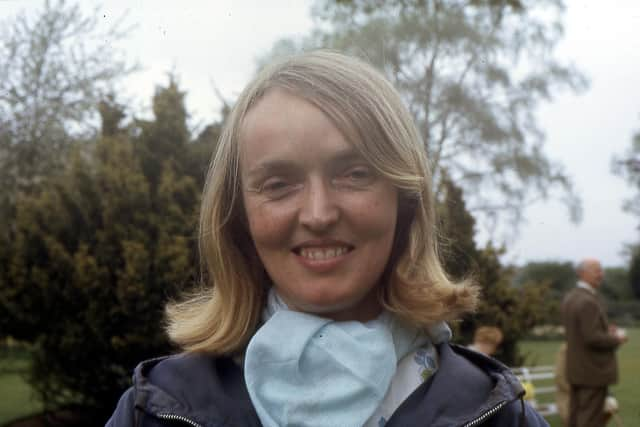Scotsman Obituaries: Celia Butterworth, Scottish medical researcher
Celia, John, Jim and myself, Olive, grew up with mum and dad in Milngavie, East Dunbartonshire, in a house facing Tannoch Loch with its ducks, swans and coots.
Celia passed the Scottish Quali (the Qualifying Test for secondary education) and went to Bearsden Academy. She was an all-rounder but chose to specialise in science. She studied pharmacy at the Tech (The Royal College of Science and Technology), later The University of Strathclyde.
Advertisement
Hide AdAdvertisement
Hide AdHowever, she realised that pharmacy does not answer questions around how a prescribed drug works in the body – pharmacological research looks into that – so left pharmacy for a job as a research assistant at the Crichton Royal Psychiatric Hospital in Dumfries.


Celia had no background in biochemistry, and the Crichton was something of a backwater, but luckily her boss was Dr Archie Todrick, senior research biochemist, and he trained her in biochemistry and laboratory techniques. In her later career in medical research Celia always recognised how much she owed to that training.
From Dumfries Celia went on to Edmonton in Canada. This was 1961, so she sailed across the Atlantic, and made good friends on the ship. In Edmonton two Japanese flatmates taught Celia to cook their dishes and use chopsticks, and the three remained lifelong friends.
At the University of Alberta in Edmonton Celia was a laboratory assistant, investigating biochemistry of the brain – all valuable experience towards a research career. She also took the opportunity to explore Canada and the USA.
On her return to Scotland in 1962, Celia won a research place in the Medical Research Council in Edinburgh, working on brain metabolism and developing means of measuring chemicals in the brain. This was the start of 30 years of research with the MRC, a busy, happy time during which she wrote her PhD on brain metabolism, and met and married John Butterworth, a research colleague.
"We had no rows, we had discussions,” said John. In 1978 they bought their house in Portobello, close to the promenade, the beach and Portobello baths, and settled in among the neighbours.
At the MRC Celia worked on enzymes in post-mortem brains from Alzheimer's, Down's and Huntington's Chorea patients. Brains could be made legally available for research by a pathologist, through the power of the Procurator Fiscal. Celia wrote around 100 research papers, some presented at symposia.
However, in 1991 the MRC moved on to molecular biology research, and closed the brain metabolism unit. Celia reluctantly took early retirement, aged 55. Li fe continued to be no less busy, just different. She trained as a volunteer adviser at the Portobello Citizens' Advice Bureau in 1991, and stayed for several years.
Advertisement
Hide AdAdvertisement
Hide AdThe CAB proved an education, an eye-opener, and most importantly, a new challenge. She learned a lot about the difficulties that people get into, and about finding ways out.
Both Celia and John loved hillwalking. A visit to the Isle of Raasay, between Skye and the mainland, encouraged them to become joint wardens of Raasay Youth Hostel for a year.
After Raasay they wardened at Minnigaff Youth Hostel, near Newton Stewart in Galloway. Then they discovered nearby Whithorn, where they bought the old police station and jail, with the field at the back where the police horses had grazed.
By the time the house was sold in 2021, because Celia and John could no longer drive from Edinburgh, the field had become a garden full of trees, shrubs and interesting plants.
While still at the CAB Celia joined PAS, the Portobello Amenity Society. An interest in local history, birds and hills all linked up with providing information boards on the prom.
She found a schoolgirl artist to illustrate a bird board and used artwork by primary schoolchildren and Victorian illustrations from the archive. There was vandalism to the boards, and then theft, but Celia's research skills found anti-theft screws, which can be screwed in, but not screwed out. Well, not easily – the thieves did their own research and learnt how to unscrew “anti-theft” screws, but Celia had halted the thefts for a while.
PAS discovered three unidentified stone pillars stored by the Council. Research showed they were chimneys, made in Lambeth of Coade stone, an 18th-century ceramic material. The crown-shaped tops were missing on two of the chimneys. The original recipe for Coade stone had died with Mrs Eleanor Coade, to keep it from business rivals.
Alison Robinson, a Portobello potter, researched a recipe and made the replacement tops. With Alison's skill and PAS experience of local government and making Lottery applications, in 2006 the three ornamental pillars were erected on the prom, looking out to sea from the community park.
Advertisement
Hide AdAdvertisement
Hide AdAs Celia grew frail her husband John took care of her, with help from the good neighbours of Bellfield Street.
A last fall brought her to the Royal Infirmary of Edinburgh, where she died, without suffering, of a late-discovered metastatic cancer.
Celia Butterworth is deeply missed by all who knew her.
Obituaries
If you would like to submit an obituary (800-1000 words preferred, with jpeg image), or have a suggestion for a subject, contact [email protected]
Subscribe
Subscribe at www.scotsman.com/subscriptions